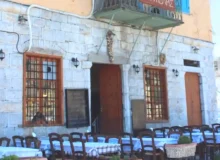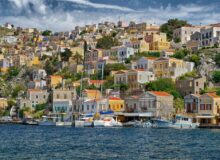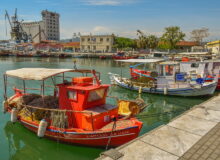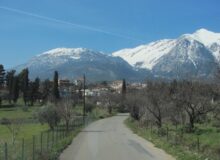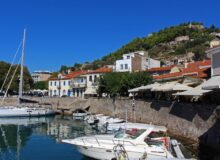The See Greece guide to Tinos in the Cyclades with a brief history and travel information on how to get there by ferry or by air and what to see and do.

Introduction to Tinos
Tinos is a stunning Greek island in the Cyclades, known for its picturesque villages, beautiful beaches, and deep religious significance. While less famous than its neighbors Mykonos and Santorini, Tinos offers an authentic Greek island experience with fewer crowds. The island is famous for the Church of Panagia Evangelistria, a major pilgrimage site, as well as its traditional marble craftsmanship, charming landscapes, and vibrant local culture.
Where is Tinos Located?

Tinos is part of the Cyclades archipelago in the Aegean Sea, situated between Andros to the northeast and Mykonos to the southeast. It is approximately:
– 10 km (6 miles) from Mykonos
– 150 km (93 miles) southeast of Athens
– 30 km (19 miles) northeast of Syros
Its central location makes it an excellent stop on a Cycladic island-hopping itinerary.
A Brief History of Tinos
Tinos has a rich history shaped by various civilizations:
Ancient & Byzantine Eras
– Inhabited since prehistoric times, Tinos was known as “Ophioussa” (Land of Snakes) due to its large snake population.
– The island was later dedicated to Poseidon, the god of the sea, and became an important religious center.
– During the Byzantine era, Tinos was a strategic naval outpost.
Venetian & Ottoman Rule
– The Venetians ruled Tinos from 1207 to 1715, leaving behind fortified villages and a strong Catholic influence (about half the island remains Catholic today).
– Under Ottoman rule (1715–1821), Tinos enjoyed relative autonomy due to its religious significance.
Modern Tinos & Greek Independence
– In 1823, a nun named Pelagia had a vision leading to the discovery of a miraculous icon of the Virgin Mary, making Tinos a major pilgrimage site.
– The island played a key role in the Greek War of Independence (1821–1829).
– Today, Tinos is famous for its marble art, with many skilled sculptors originating from the island.

What to See & Do on Tinos
1. Religious & Cultural Sites
– Panagia Evangelistria Church – The most famous landmark, housing the miraculous icon of the Virgin Mary. Pilgrims often crawl up the Megalochari Street on their knees as a sign of devotion.
– Church of Agios Nikolaos – A beautiful Catholic church in Tinos Town.
– Monastery of the Holy Trinity (Agiou Triados) – Offers panoramic views of the island.
2. Traditional Villages

– Pyrgos – The marble-carving capital of Tinos, home to the Marble Art Museum and stunning neoclassical mansions.
– Volax – A surreal village surrounded by giant boulders, known for its basket-weaving traditions.
– Kardiani – A lush, green village with stunning sea views and traditional architecture.
– Arnados – A hidden gem with cobbled streets and medieval charm.
3. Beaches
– Kolymbithra Beach – A sandy beach with clear waters, split into two bays (one organized, one more secluded).
– Agios Ioannis Porto – A long sandy beach near Tinos Town, great for families.
– Agios Sostis – A quiet, unspoiled beach with turquoise waters.
– Livada Beach – A peaceful pebble beach surrounded by greenery.
4. Outdoor Activities
– Hiking – Tinos has a network of old walking paths (many restored) leading to villages, churches, and scenic viewpoints. Popular trails include Tinos Town to Ktikados and Volax to Falatados.
– Windsurfing & Kitesurfing – The beaches of Kolymbithra and Pachia Ammos are ideal for water sports.
– Cycling – The island’s rugged terrain attracts mountain bikers.
5. Local Cuisine & Products
– Artichokes – Tinos is famous for its artichokes, often used in local dishes.
– Louza – A cured pork delicacy similar to Spanish jamón.
– Local Cheeses – Try kopanisti (a spicy cheese) and graviera (a mild, hard cheese).
– Wine – Visit local wineries like Domaine de Kalathas for tastings.
How to Get to Tinos
By Ferry
The most common way to reach Tinos is by ferry:
– From Athens (Piraeus Port):
– Regular ferries (3.5–4.5 hours)
– High-speed ferries (2–2.5 hours)
– Operated by Seajets, Blue Star Ferries, Hellenic Seaways
– From Mykonos:
– Just 20–30 minutes by ferry, with frequent connections.
– From Santorini, Naxos, Paros, Syros:
– Seasonal connections, usually in summer.
By Air
Tinos does not have an airport, but you can fly to nearby islands and take a ferry:
– Mykonos Airport (JMK) – 30-minute ferry to Tinos.
– Syros Airport (JSY) – 1-hour ferry to Tinos.
– Athens Airport (ATH) – Take a bus/taxi to Piraeus port, then a ferry.
Best Time to Visit
– April–June & September–October – Ideal for mild weather and fewer crowds.
– July–August – Peak season, busy with pilgrims (August 15 is a major religious festival).
– Winter – Quiet, with some businesses closed, but great for a peaceful retreat.
Conclusion
Tinos is a captivating blend of spirituality, tradition, and natural beauty. Whether you’re exploring its historic villages, relaxing on secluded beaches, or admiring its marble artistry, the island offers an authentic Greek experience away from mass tourism. With easy ferry access from Athens and nearby islands, Tinos is a must-visit destination in the Cyclades.















